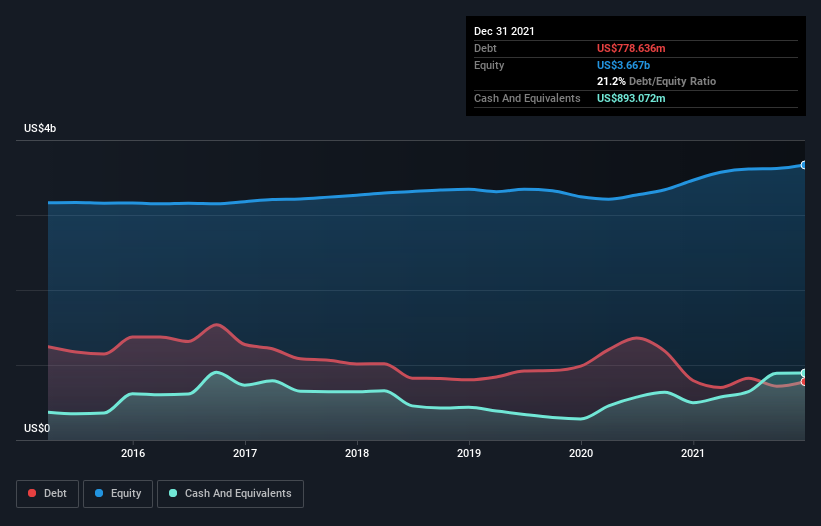Howard Marks put it nicely when he said that, rather than worrying about share price volatility, 'The possibility of permanent loss is the risk I worry about... and every practical investor I know worries about.' When we think about how risky a company is, we always like to look at its use of debt, since debt overload can lead to ruin. We can see that CAP S.A. (SNSE:CAP) does use debt in its business. But the more important question is: how much risk is that debt creating?
What Risk Does Debt Bring?
Debt assists a business until the business has trouble paying it off, either with new capital or with free cash flow. In the worst case scenario, a company can go bankrupt if it cannot pay its creditors. However, a more common (but still painful) scenario is that it has to raise new equity capital at a low price, thus permanently diluting shareholders. By replacing dilution, though, debt can be an extremely good tool for businesses that need capital to invest in growth at high rates of return. The first step when considering a company's debt levels is to consider its cash and debt together.
See our latest analysis for CAP
How Much Debt Does CAP Carry?
The chart below, which you can click on for greater detail, shows that CAP had US$778.6m in debt in December 2021; about the same as the year before. However, its balance sheet shows it holds US$893.1m in cash, so it actually has US$114.4m net cash.

How Strong Is CAP's Balance Sheet?
We can see from the most recent balance sheet that CAP had liabilities of US$1.62b falling due within a year, and liabilities of US$1.32b due beyond that. Offsetting these obligations, it had cash of US$893.1m as well as receivables valued at US$369.2m due within 12 months. So its liabilities total US$1.68b more than the combination of its cash and short-term receivables.
This deficit is considerable relative to its market capitalization of US$1.72b, so it does suggest shareholders should keep an eye on CAP's use of debt. This suggests shareholders would be heavily diluted if the company needed to shore up its balance sheet in a hurry. While it does have liabilities worth noting, CAP also has more cash than debt, so we're pretty confident it can manage its debt safely.
Better yet, CAP grew its EBIT by 114% last year, which is an impressive improvement. That boost will make it even easier to pay down debt going forward. When analysing debt levels, the balance sheet is the obvious place to start. But it is future earnings, more than anything, that will determine CAP's ability to maintain a healthy balance sheet going forward. So if you're focused on the future you can check out this free report showing analyst profit forecasts.
Finally, a company can only pay off debt with cold hard cash, not accounting profits. While CAP has net cash on its balance sheet, it's still worth taking a look at its ability to convert earnings before interest and tax (EBIT) to free cash flow, to help us understand how quickly it is building (or eroding) that cash balance. During the last two years, CAP produced sturdy free cash flow equating to 75% of its EBIT, about what we'd expect. This cold hard cash means it can reduce its debt when it wants to.
Summing up
Although CAP's balance sheet isn't particularly strong, due to the total liabilities, it is clearly positive to see that it has net cash of US$114.4m. And it impressed us with its EBIT growth of 114% over the last year. So we are not troubled with CAP's debt use. There's no doubt that we learn most about debt from the balance sheet. However, not all investment risk resides within the balance sheet - far from it. For instance, we've identified 3 warning signs for CAP (1 is significant) you should be aware of.
At the end of the day, it's often better to focus on companies that are free from net debt. You can access our special list of such companies (all with a track record of profit growth). It's free.
New: AI Stock Screener & Alerts
Our new AI Stock Screener scans the market every day to uncover opportunities.
• Dividend Powerhouses (3%+ Yield)
• Undervalued Small Caps with Insider Buying
• High growth Tech and AI Companies
Or build your own from over 50 metrics.
Have feedback on this article? Concerned about the content? Get in touch with us directly. Alternatively, email editorial-team (at) simplywallst.com.
This article by Simply Wall St is general in nature. We provide commentary based on historical data and analyst forecasts only using an unbiased methodology and our articles are not intended to be financial advice. It does not constitute a recommendation to buy or sell any stock, and does not take account of your objectives, or your financial situation. We aim to bring you long-term focused analysis driven by fundamental data. Note that our analysis may not factor in the latest price-sensitive company announcements or qualitative material. Simply Wall St has no position in any stocks mentioned.
About SNSE:CAP
CAP
Engages in iron ore mining, steel production, steel processing, and infrastructure businesses in Chile and internationally.
Good value with reasonable growth potential.
Similar Companies
Market Insights
Community Narratives



